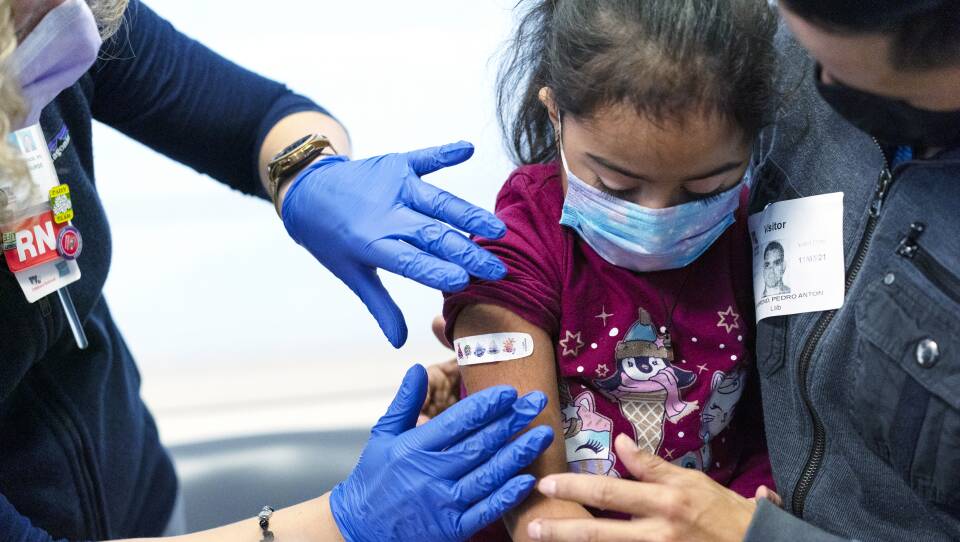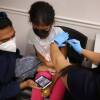The latest state data show a continued slow start on COVID-19 vaccinations for the youngest children and persistent racial disparities in vaccinations among kids aged 5 to 11.
Six weeks after COVID-19 vaccines became available for children under the age of 5, just 11% of kids in that age group have received at least one dose. And while the numbers in the youngest age group are still too low to see clear trends based on racial identity of those getting vaccinated and those who are not, experts say there are early signs the age group may be subject to the same disparities seen among older children.
Statewide, 59% of kids aged 5-11 have gotten at least one shot. That's compared to a national average of 37%.
"Compared to other states, we're doing well," said Alan Geller, senior lecturer in social and behavioral sciences at the Harvard TH Chan School of Public Health. "But in Massachusetts, for kids 5 to 11, half of the communities are way behind the other ones."
The vaccination rates are particularly troubling in many communities with higher percentages of children of color, Geller said. For example, just 35% of 5- to 11-year-olds in Springfield have gotten a shot. In Worcester it's 41%, 45% in Lowell, and 49% of kids that age are at least partially vaccinated in Lynn.
Within Boston, the racial disparities in youth vaccination are stark. In data released Friday, the Boston Public Health Commission reported 73% of white children aged 5-11 in the city are fully vaccinated, compared to just 35% of Latino children and 28% of Black kids.
Also, the number of children getting vaccinated hasn't improved much in the last several months. Since April, he said, the state average has crept from 49% with one shot to the current 59%.
"We're completely stuck in Massachusetts with kids 5 to 11," Geller said, adding that most of the shots given to kids in that age group happened in the initial months they were available. "But [the rate of vaccinations] stopped like a car stuck in quicksand. And we need new strategies. ... We have to look really critically and say, why is that? And what can we do better?"
"We're completely stuck in Massachusetts with kids 5 to 11. [The rate of vaccinations] stopped like a car stuck in quicksand."Alan Geller, senior lecturer at the Harvard TH Chan School of Public Health
Earlier this year, Geller and Dr. Lloyd Fisher, former president of the Massachusetts chapter of the American Academy of Pediatrics, jointly published a paper in the journal Clinical Infectious Diseases that showed significant disparities in vaccination of adolescents, aged 12-19, based on race and household income.
"The data is [now] showing the exact same pattern in the 5- to 11-year-olds," Fisher said. "We are seeing the same sort of factors contribute to vaccination rates."
Fisher, who is now the medical director of immunization initiative of the state chapter of the AAP, said a number of factors could be contributing to the disparity.
"We know that in communities of color and lower income communities, patients in those areas are less likely to have a primary care provider," Fisher said.
That, he said, could make it harder for parents in those communities to get accurate information about the benefits and risks of vaccination.
"There is confusing information when it comes to this vaccine," he said. "There has been a lot of various information out there — some better than others. So it's really important that you have somebody that you can trust to ask."
Fisher said he's hopeful more parents of young children will choose to get them vaccinated after their regular pediatrician appointments.
"I think it's going to be a much slower and, hopefully, steadier rise to vaccination as all of these children come in for their routine visits, especially the really young children," he said.
Even though there's no shortage of COVID-19 vaccine doses in Massachusetts, Fisher said, issues of access might still be contributing to vaccination disparities. He offered the example of a lower-income person who may not be able to take time off work to get their child vaccinated or face challenges with transportation getting to and from a health care provider.
In communities like Chelsea, programs that aimed to get around those challenges were successful in vaccinating adults. Now, they're trying to replicate that success in kids.
"It's about being accessible at the time in which works for those families and those communities," said Dr. Priya Sarin Gupta, a physician at Harvard Medical School and Massachusetts General Hospital, and the medical director for community-based clinical programs at Mass General Brigham.
Gupta runs a mobile vaccination program that's trying to reach kids in Chelsea and similar communities.
"Having walk-in clinics that are accessible to families - where individuals maybe work more than one job and don't have the luxury of pulling their children out of whatever their daytime activity is from 8 to 5 to take them to get their shots -certainly helps," she said.
"The other piece is at the vaccine clinics, having someone available there that can speak the language that is best understood by individuals, to explain the vaccine and to explain what it's useful for and to explain its safety," Gupta added.
State public health officials say they're focused on vaccinating kids in the hardest hit communities through a Vaccine Equity Initiative that includes clinics at schools, Head Start programs, and other trusted locations, including during February and April school vacation weeks . The state is also running a media campaign to promote pediatric vaccination on billboards, MBTA signage, convenience store ads, and on social and digital platforms.








